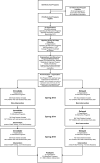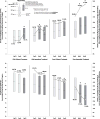Physical activity outcomes in afterschool programs: A group randomized controlled trial
- PMID: 27397608
- PMCID: PMC5014716
- DOI: 10.1016/j.ypmed.2016.07.002
Physical activity outcomes in afterschool programs: A group randomized controlled trial
Abstract
Introduction: Afterschool programs (ASPs) across the US are working towards achieving the standard of all children accumulating 30min of moderate-to-vigorous physical activity (MVPA) during program time. This study describes the two-year impact of an intervention designed to assist ASPs meeting the 30min/day MVPA standard.
Methods: Using a two-year delayed treatment, group randomized controlled trial, 20 ASPs serving ~1700 children/year (6-12yrs) were randomized to either an immediate (n=10, baseline-2013 and 2yrs intervention fall-2013-to-spring-2015) or delayed group (n=10, baseline 2013-2014 and 1yr intervention fall-2014-to-spring-2015). The intervention, Strategies-To-Enhance-Practice (STEPs), focused on programming MVPA in the daily schedule, training of staff and leaders, and ongoing technical support/assistance. Accelerometry-derived proportion of children meeting the 30min/day MVPA standard was measured in the spring of each year. Mixed model logistic regressions were used to examine the change in the odds of achieving the MVPA standard. Analyses were conducted in 2015. Data were collected in one southeastern US state.
Results: Immediate boys (n=677) and delayed girls (n=658) increased the percent achieving 30min MVPA/day from 35.9% to 47.0% (odds ratio [OR]=1.88, 95% CI 1.18-3.00) and 13.1% to 19.1% (OR=1.42, 95% CI 1.03-1.96). Immediate girls (n=613) and delayed boys (n=687) exhibited a nonsignificant increase from 19.1% to 21.6% (OR=1.20, 95% CI 0.84-1.72) and 29.0% to 31.3% (OR=1.13, 95%CI 0.80-1.58).
Conclusions: STEPs can have an impact on children's MVPA and time spent sedentary, yet was unable to fully achieve the goal of all children accumulating 30minMVPA/day. Additional efforts are need to identify strategies ASPs can use to meet this important public health standard.
Trial registration: ClinicalTrials.gov NCT02144519.
Keywords: Accelerometer; Intervention; Obesity; School; Standards.
Copyright © 2016 Elsevier Inc. All rights reserved.
Conflict of interest statement
Potential conflicts of interest: The authors declare that there are no conflicts of interest
Figures
References
-
- Afterschool Alliance. America After 3 PM: A Household Survey on Afterschool in America. Washington, DC: Afterschool Alliance; 2014.
-
- First lady announces two new commitments to healthy eating and physical activity afterschool. [ http://www.afterschoolalliance.org/afterschoolsnack/printPage.cfm?idBlog...; http://ahealthieramerica.org/media/news-releases/#5482,news]
-
- Beets MW, Wallner M, Beighle A. Defining standards and policies for promoting physical activity in afterschool programs. Journal of School Health. 2010;80:411–417. - PubMed
-
- Moore JB, Program: Move More North Carolina Recommended Standards for After-School Physical Activity. Health Education and Behavior. 2009;36:637–639. - PubMed
-
- Moore JB, Schneider L, Lazorick S, Shores KA, Beighle A, Jilcott SB, Newkirk J. Rationale and development of the Move More North Carolina: Recommended Standards for After-School Physical Activity. J Public Health Manag Pract. 2010;16:359–366. - PubMed
Publication types
MeSH terms
Associated data
Grants and funding
LinkOut - more resources
Full Text Sources
Other Literature Sources
Medical



